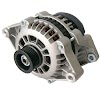Types of Line Supports
The poles (or) structures on which the Overhead line conductors are strung are known as “Line supports”. Generally for transmission and distribution of Electric power the following are the different types of line support, namely
1. Wooden poles. [upto 20 kV]
2. Steel poles. [upto 33 kV]
3. Reinforced cement concrete (R.C.C) poles. [upto 33 kV]
4. Pre-stressed cement concrete (P.S.C.C) poles. [upto 11kV]
5. Towers. [33kv to any voltage.]
Wooden poles: This types of poles are mainly used
for low voltage applications i.e., for distribution power in rural
electrification. Wooden poles are used where the availability of wood is plenty.
In order to
obtain higher transverse strength the wooden poles are designed in A (or) H
type and are as shown in Fig. 3.1.
Advantages:
1. Wooden supports are cheap.
2. Easily available.
3. Good insulting property.
4. Widely used for distribution purpose in rural areas.
Disadvantages:
1. Generally these are tend to rot below the ground level causing the foundation failures.
2. Limited span length (upto 50 meters).
3. Life of wooden poles is very short (20-25 years).
4. It is not used for voltage higher than 20 kV.
5. This type of poles requires regular inspection.
6. Less mechanical strength.
Steel poles: The main disadvantages of wooden poles are overcome by using steel poles. These are mainly available in three types, namely
i. Tubular poles.
ii. Rail poles.
iii. Rolled steel poles
The steel poles with a height of 9 to 11 metres will be used for distribution lines and with a height of 11 to 13 metres are used for transmission lines at 11 kV and 33 kV respectively.
Advantages:
i. Higher mechanical strength as compared to wooden poles.
ii. Life of the steel poles more. By proper painting the poles regularly the life poles is increased to 40-50 years.
iii. These poles can be used up to 33 kV operating voltage.
iv. Span length is (50-80metres) as compared to wooden poles.
Reinforced Cement
Concrete (R.C.C.) Poles :
In the recent years the R.C.C. poles
are mainly using for distribution purpose. Fig. 3.2 shows the R.C.C. poles for
single and double circuit. The holes in the poles provides the facility for
climbing of poles. These are used for spans of 80 to 200 m.
Advantages:
1. Greater mechanical strength.
2. Longer life
3. Good looking.
4. Requires little maintenance.
5. Good insulating property as compared to steel poles.
Disadvantages:
1. Transmission cost of R.C.C. Poles is high.
2. Errection of poles is also difficult.
Pre-stressed Cement
Concrete Poles (PSCC-poles):
The main disadvantages of RCC poles are overcome by using
PSCC poles. These poles are lighter weight hence transportation, handling and
errection are easier.
This type of poles are used upto 11 kV L.T. Lines.
Towers: The
wooden, steel and R.C.C. poles are used for limited operating voltages upto a
maximum of 33 kV and limited span lengths. Hence for long transmission
distances at higher voltages steel towers are mainly used.
Fig. 3.3 shows the different shapes of the steel towers
employed for transmission of power.
Advantages:
1. High mechanical strength.
2. Longer life.
3. Can withstand for most severe climatic conditions.
4. Used for longer spans.
5. Reliability of supply is more.
6. Lightning troubles are reduced.
7. For any operating voltage these can be used.
Disadvantages
1. It takes more for errection.
2. Towers must periodically painted (or) Galvani











0 Comments